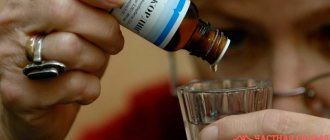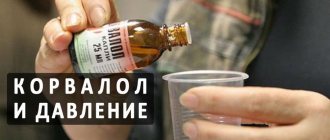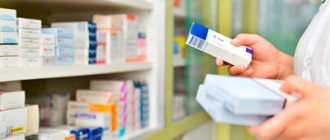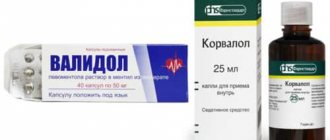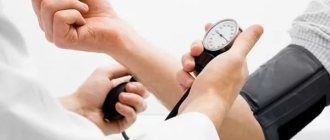Many people know that combining medications and alcoholic beverages is strictly contraindicated. This is explained by the fact that such a “cocktail” has a detrimental effect on human health. However, some patients believe that if the medicine contains alcohol, it can be mixed with alcohol. However, this opinion is erroneous.
A striking example of a toxic combination is Corvalol and alcohol. And the point is not only that the medicine and alcoholic drinks have the opposite effect: the drug calms, while alcohol increases nervous excitability. Both products contain ethanol (ethyl alcohol) and flavor enhancers, which improve the taste of alcohol and enhance the therapeutic effect of Corvalol. For this reason, such a combination threatens with unpredictable consequences.
The effect of Corvalol on the human body
Corvalol is a medical drug with a pronounced sedative, antispasmodic, and vasodilator effect. Its use is justified for functional disorders of the heart and blood vessels, problems with blood pressure, disorders of the nervous system and digestive organs. The drug is available in the form of drops for oral use. In appearance it is a clear liquid with a characteristic menthol aroma.
Corvalol has a sedative, vasodilator and antispasmodic effect
The medication contains the following components:
- α-bromoisovaleric acid ethyl ester;
- phenobarbital;
- ethanol (95%);
- sodium hydroxide;
- peppermint oil;
- distilled water.
The dose of the drug depends on the symptoms, as well as the age of the patient. If the patient wants to get rid of problems with the heart and blood vessels, then the recommended dose for adults is from 15 to 30 drops, and for patients of a younger age category - 15 drops. To relieve spasms in the gastrointestinal tract, take 50 drops of the drug. In the latter case, the tincture is taken before eating. When taking Corvalol, remember that the medication can cause side effects if the dosage is not correct.
The therapeutic effect of the drug is due to its constituent components:
- Thanks to ethyl ether, alcohol, and valeric acid, the medication has a pronounced sedative effect.
- Phenobarbital calms, normalizes sleep, dilates blood vessels.
- Peppermint oil suppresses muscle spasms, eliminates inflammation and also promotes vasodilation.
After taking Corvalol, slight drowsiness occurs. The drug quickly normalizes the functioning of the nervous system during stressful conditions, restores the functionality of the gastrointestinal tract, and stops heart attacks of mild and moderate intensity.
The medication is contraindicated if you are allergic to its components or have severe kidney or liver diseases.
Many people wonder whether it is possible to drink Corvalol during pregnancy and lactation. This is possible only after the doctor’s permission and under his strict supervision. In this case, the nursing mother must transfer the baby to artificial feeding.
Overdose
Due to the fact that the drug contains bromine compounds, an overdose can provoke:
- depression;
- rhinitis;
- inflammation of the conjunctiva;
- lack of coordination;
- drug dependence.
With prolonged use, patients note the appearance of dizziness, increased drowsiness, and the appearance of allergic reactions.
With liver failure, a rash may appear, accompanied by severe itching. Each meal will make the rash worse, even if Corvalol is stopped. Patients with phenobarbital poisoning note the appearance of edema, which indicates an exacerbation of renal failure. If such a reaction occurs, the patient should urgently call a doctor and, if necessary, be hospitalized.
Effect of alcohol
Most modern people regularly drink alcohol-containing drinks because they eliminate anxiety, give a feeling of relaxation, and have a warming effect. Some people believe that a small dose of alcohol can relieve heartburn. In addition, more recently, alcohol was used to treat ulcerative defects of the digestive system. To do this, an esophageal probe is fixed over the erosion on the gastric or intestinal mucosa and cauterized with ethanol. As a result, the sensitivity of the nerve processes decreases, pain decreases and the ulcers heal faster.
An overdose of alcohol causes nausea, vomiting, and impaired coordination.
To experience the benefits of alcohol without harming your health, drink only high-quality drinks. A safe single dose corresponds to 30 ml of vodka, cognac or other strong drink, 75 ml of sweet wine, 100 ml of champagne. This portion contains 10 g of pure ethyl alcohol.
Most alcoholic drinks (including beer) contribute to the destruction of the liver. After entering the body, ethanol is transformed into alcohol dehydrogenase, and then into toxic acetaldehyde. If you drink a little alcohol on one day, and then on the second day, the liver does not have time to break it down into carbon dioxide and water for natural elimination. In this case, acetyl CoA (acetyl coenzyme A) spreads through the bloodstream and enters the brain, destroying its cells.
With systematic consumption of alcoholic beverages, the functionality of the liver is impaired, and brain neurons atrophy. Then the signs that are characteristic of all alcoholics appear - impaired memory, attention, decreased intelligence.
An overdose of alcohol-containing drinks is manifested by nausea, bouts of vomiting, dizziness, loss of coordination, etc. The same symptoms occur after an independent increase in the dose of Corvalol. But if after exceeding the dosage of the drug after some time the patient can concentrate again, then after regular consumption of alcohol it is almost impossible to restore the original functionality of the brain.
Health care
Before hospitalization the following is performed:
- breathing control. To ensure ventilation of the lungs, the oral cavity is cleared of vomit, and the tongue is fixed with a holder. It is possible to use an airway; in case of coma, intubation is necessary;
- gastric lavage. If the patient is unconscious, it is performed through a probe;
- maintenance therapy. Intravenous administration of glucose solution, vitamins, insulin or other drugs - the set is determined by the patient’s condition;
- symptomatic treatment. Relieving pain, restoring normal breathing, lowering blood pressure, etc.;
- if the body temperature is low, the person freezes - warming up (with heating pads).
After providing primary care for acute ethanol poisoning, doctors at the NarcoDoc clinic recommend hospitalization in a hospital. In the clinic, they continue to monitor the patient’s condition, treat him, and relieve possible complications of intoxication.
Contact our specialists for treatment of alcoholism followed by rehabilitation, call: +7
Compatibility of Corvalol and alcohol
The opinion that Corvalol is a safe drug is a misconception. The combination of this medication with alcoholic beverages is especially dangerous. The compatibility of Corvalol and alcohol on a five-point scale is 3 points. This means that such a combination threatens not only human health, but also his life.
The combination of Corvalol and alcohol is dangerous to health
When combined with the drug and ethanol, the sedative and vasodilating effects increase. Corvalol after alcohol enhances the sedative effect, the activity of the nervous system is inhibited, and the liver is subjected to double load.
In addition, when the drug is combined with alcohol, a strong lack of coordination is observed. The man cannot stand on his feet and falls. In some cases, speech function and perception are impaired.
Since Corvalol calms and relaxes smooth muscles, ethanol metabolites will accumulate in the body, increasing general poisoning. As a result, the hangover syndrome becomes more pronounced.
It is strongly not recommended to take Corvalol with low-alcohol carbonated drinks (including beer) at the same time. These alcohol-containing products are absorbed more slowly, toxic substances accumulate in the body, causing severe poisoning. The combination of the drug with high-quality vodka or wine is not so dangerous, but also extremely undesirable.
When Corvalol is taken together with alcohol, the functioning of many organs and systems is disrupted.
How to speed up elimination at home
The action of barbiturates lasts from 2 to 24 hours. It all depends on what drug the person is abusing. Depending on this, the effect of detoxification at home will also be different.
To speed up elimination, it is necessary to rinse the stomach. Even if several hours have passed since consumption. To do this, drink up to 2 liters of water and induce a gag reflex. This can be done several times.
After this, activated carbon or other sorbents are taken in an age- or weight-specific dose.
The next step is to drink plenty of compote, water, and tea. But you don’t need to drink 2-3 liters at once, as the water load increases greatly. This should be done gradually, over 5-8 hours. It is important to perform minimal activity: move your arms, legs, walk around the apartment, the street.
All these actions will not lead to a quick cleansing of the body or stopping the action of the substance. But they will help start metabolism and speed up excretion a little.
Consequences of co-administration
As already mentioned, the combination of Corvalol with alcoholic drinks is life-threatening; such a “cocktail” negatively affects all body systems:
- Central nervous system. A possible effect after taking Corvalol is a half-asleep state, lethargy, and apathy. This is explained by the fact that the medication depresses the central nervous system. Ethanol has the same effect. If you drink Corvalol and any alcohol-containing drink at the same time, then, against the background of severe depression of the nervous system, coordination of movements and speech function are impaired. It is for this reason that many alcoholics suffer from frequent stress and psychological disorders (hallucination, paranoia, delirium tremens, etc.). With frequent combination of Corvalol with alcohol, dependence develops, that is, the patient is forced to constantly increase the single dose in order to achieve the required therapeutic effect. If you abruptly stop taking the medication, withdrawal symptoms occur (as people say, withdrawal symptoms).
- Kidneys and liver. To avoid negative effects, you should avoid combining Corvalol with alcohol, as they put a lot of strain on the liver. If the patient suffers from alcoholism or has gotten rid of this addiction, then after taking Corvalol the likelihood of damage to liver cells increases. As a result, the functionality of the organ is impaired and the concentration of ethanol in the bloodstream increases. This condition can provoke general poisoning of the body. When Corvalol is taken together with low-alcohol drinks, the kidneys are subjected to severe stress, and toxic substances are removed from the blood more slowly.
- The cardiovascular system. The combination of alcohol and Corvalol threatens hemorrhages (including cerebral). This is explained by the fact that both the drug and ethanol provoke vasodilation. This combination is quite dangerous for any adult, let alone the immature body of adolescents. You should not drink alcohol after Corvalol or vice versa, otherwise the likelihood of damage to blood vessels or myocardium increases. In addition, when a person drinks a lot of alcohol, his sense of proportion disappears, and therefore he is unable to control the dose of medication. An overdose of ethanol and Corvalol threatens sudden cardiac arrest, rupture of the heart muscle wall, heart attack, or even death.
- Digestive tract. The combination of alcohol-containing drinks and Corvalol affects intestinal motility, which causes chronic constipation.
Here are the main consequences of the destructive tandem of ethanol and Corvalol. Based on the foregoing, combining the drug with alcoholic beverages is strictly not recommended.
Analogs
Barbiturates, as a pharmacological group, are most similar in action to sedatives, alcohol and opiates. Alcohol or opiates are thought to potentiate the effects of barbiturates.
Currently, approximately 10 drugs from the barbiturate group are registered in the Russian Federation. They are mainly sold by prescription and used for anesthesia or sedation. Such drugs include:
- Butalbutal;
- Nembutal;
- Alurat;
- Secobarbital;
- Aprobarbital.
The main representative of the group of barbiturates is phenobarbital. This is what drug addicts abuse most often.
Valocordin and Corvalol are also dangerous. Drugs can cause mental dependence, which can become physical. These drugs contain a small dose of phenobarbital, which causes all the effects of the drug.
How long after Corvalol can you drink alcohol?
Despite all the prohibitions, sometimes unforeseen situations happen when a person who has consumed alcohol is forced to take Corvalol or vice versa. Then he begins to look for an answer to the question of how long after taking the drug he can drink alcohol. There is no definite answer to the question; the time period depends on the volume of alcohol consumed and the individual characteristics of the body.
Doctors categorically prohibit combining Corvalol with alcoholic beverages
The therapeutic effect after taking the medicine appears within 15–45 minutes and lasts for 4–6 hours. When treating inflammation of the colon mucosa, the dose of the drug is increased, so its effectiveness decreases after 8–10 hours.
The therapeutic effect ceases, and the half-life occurs in 3–4 days. This means that with a single dose, the body is freed from the substances into which the medication breaks down in about 7 days. Based on this, you can take Corvalol without health consequences a week before the feast.
Thus, Corvalol with alcohol is a very dangerous combination that can lead to serious consequences. That is why doctors categorically prohibit drinking alcohol during treatment with the drug. Patients with severe liver or kidney diseases, or a genetic predisposition to drug or alcohol dependence, take Corvalol exclusively under the supervision of a doctor.
Signs of barbituromania
Addiction usually appears gradually. Relatives should always pay attention to changes in behavior. It is common for barbiturate addicts to have mood swings. During the period of the drug's effect, they are more talkative, less shy, and easy to make contact with. After the effect ends, they are always aggressive, can be rude or even start fighting, and are looking for money to get a new dose.
Barbiturates have strong effects on the brain. Those who abuse them begin to have problems with speech. They speak poorly, do not remember well what they talked about and what they were asked to do.
Barbiturate addiction also occurs in people who do not know about it. For example, grandparents take Corvalol every day before bed. If they don't do this, they won't be able to sleep well, calm down, or stop worrying.
Barbiturates are inexpensive drugs, but they are often combined with either alcohol or opiates. This leads to rapid spending of money and financial difficulties.
People who abuse pharmaceutical drugs always have bottles of pills and medicine bottles at home. While the drug is taking effect, they do not think about hiding the traces of their addiction, and then they simply forget about it.
Another important episode is that the effect of barbiturates is similar to alcohol intoxication. But there is no smell of alcohol. If a person behaves as if drunk, but there is no smell of alcohol, he is most likely under the influence of barbiturates.
